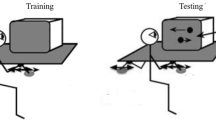Abstract
The current studies explore the informational basis of the coupling in human rhythmic movement coordination tasks. Movement stability in these tasks is an asymmetric U-shaped function of mean relative phase; 0° is maximally stable, 90° is maximally unstable and 180° is intermediate. Bingham (2001, 2004a, 2004b) hypothesized that the information used to perform coordinated rhythmic movement is the relative direction of movement, the resolution of which is determined by relative speed. We used an experimental paradigm that entails using a circular movement to produce a linear motion of a dot on a screen, which must then be coordinated with a linearly moving computer controlled dot. This adds a component to the movement that is orthogonal to the display. Relative direction is not uniquely defined between orthogonal components of motion, but relative speed is; it was therefore predicted that the addition of the component would only introduce a symmetric noise component and not otherwise contribute to the U-shape structure of movement stability. Results for experiment 1 supported the hypothesis; movement that involved the additional component was overall less stable than movement that involved only the parallel component along which relative direction can be defined. Two additional studies ruled out alternative explanations for the pattern of data in experiment 1. Overall, the results strongly implicate relative direction as the information underlying performance in rhythmic movement coordination tasks.








Similar content being viewed by others
Notes
Note that all the histograms have been scaled to the same size as required to show the extremely stable behavior in the Linear 0° case
References
Batschelet E (1981) Circular statistics in biology. Academic, New York
Bingham GP (2001) A perceptually driven dynamical model of rhythmic limb movement and bimanual coordination. In: Proceedings of the 23rd annual conference of the cognitive science society. Lawrence Erlbaum, Mahwah, pp 75–79
Bingham GP (2004a) A perceptually driven dynamical model of bimanual rhythmic movement (and phase perception). Ecol Psychol 16(1):45–53
Bingham GP (2004b) Another timing variable composed of state variables: phase perception and phase driven oscillators. In: Hecht H, Savelsbergh GJP (eds) Advances in psychology 135: time-to-contact. Elsevier, Amsterdam
Bingham GP, Schmidt RC, Zaal FTJM (1999) Visual perception of relative phasing of human limb movements. Percept Psychophys 61:246–258
Bingham GP, Zaal FTJM, Shull JA, Collins D (2000) The effect of frequency on visual perception of relative phase and phase variability of two oscillating objects. Exp Brain Res 136:543–552
Bogaerts H, Buekers MJ, Zaal FTJM, Swinnen SP (2003) When visuo-motor incongruence aids motor performance: the effect of perceiving motion structures during transformed visual feedback on bimanual coordination. Behav Brain Res 138:45–57
Buekers MJ, Bogaerts HP, Swinnen SP, Helsen WF (2000) The synchronization of human arm movements to external events. Neuro Lett 290:181–184
Collins DR, Turvey MT (1997) A stochastic analysis of superposed rhythmic synergies. Hum Mov Sci 116:333–380
Fisher NI (1993) Statistical analysis of circular data. Cambridge University Press, Cambridge
Haken H, Kelso JAS, Bunz H (1985) A theoretical model of phase transitions in human hand movements. Biol Cyber 51:347–356
Jammalamadaka SR, SenGupta A (2001) Topics in circular statistics. World Scientific Publishing, River Edge
Johansson G (1950) Configurations in event perception. Almqvist & Wiksell, Uppsala
Johansson G (1986) Relational invariance and visual space perception: on perceptual vector analysis of the optic flow. Acta Psychol 63:89–101
Kelso JAS (1981) On the oscillatory basis of movement. Bull Psychon Soc 18:63
Kelso JAS (1984) Phase transitions and critical behavior in human bimanual coordination. Am J Phys 15:R1000-R1004
Lee TD, Almeida QJ, Chua R (2002) Spatial constraints in bimanual coordination: influences of effector orientation. Exp Brain Res 146:205–212
Mardia KV (1972) Statistics of directional data. Academic, New York
Mechsner F, Knoblich G (2004) Do muscles matter for coordinated action?. J Exp Psychol Hum 30(3):490–503
Mechsner F, Kerzel D, Knoblich G, Prinz W (2001) Perceptual basis of bimanual coordination. Nature 414:69–73
Michaels CF (1988) S-R compatibility between response position and destination of apparent motion: Evidence of the detection of affordances. J Exp Psychol Hum 14(2):231–240
Michaels CF, Stins JF (1997) An ecological approach to stimulus-response compatibility. In: Hommel B, Prinz W (eds) Theoretical issues in stimulus-response compatibility. Elsevier, Amsterdam, pp 333–360
Schmidt RC, Carello C, Turvey MT (1990) Phase transitions and critical fluctuations in the visual coordination of rhythmic movements between people. J Exp Psychol Hum 16:227–247
Swinnen SP, Jardin K, Verschueren S, Meulenbroek R, Franz L, Dounskaia N, Walter CB (1998) Exploring interlimb constraints during bimanual graphic performance: effects of muscle grouping and direction. Behav Brain Res 90:79–87
Temprado JJ, Laurent M (2004) Attentional load-associated with performing and stabilizing a between-persons coordination of rhythmic limb movements. Acta Psychol 115:1–16
Temprado JJ, Swinnen SP, Carson RG, Tourment A, Laurent M (2003) Interaction of directional, neuromuscular and egocentric constraints on the stability of preferred bimanual coordination patterns. Hum Mov Sci 22:339–363
Wilson AD, Bingham GP, Craig JC (2003) Proprioceptive perception of phase variability. J Exp Psychol Hum 29(6):1179–1190
Wilson AD, Collins DR, Bingham GP (2005) Perceptual coupling in rhythmic movement coordination—stable perception leads to stable action. Exp Brain Res (in press)
Wimmers RH, Beek PJ, van Wieringen PCW (1992) Phase transitions in rhythmic tracking movements: a case of unilateral coupling. Hum Mov Sci 11:217–226
Zaal FTJM, Bingham GP, Schmidt RC (2000) Visual perception of mean relative phase and phase variability. J Exp Psychol Hum 26:1209–1220
Author information
Authors and Affiliations
Corresponding author
Rights and permissions
About this article
Cite this article
Wilson, A.D., Collins, D.R. & Bingham, G.P. Human movement coordination implicates relative direction as the information for relative phase. Exp Brain Res 165, 351–361 (2005). https://doi.org/10.1007/s00221-005-2301-2
Received:
Accepted:
Published:
Issue Date:
DOI: https://doi.org/10.1007/s00221-005-2301-2




